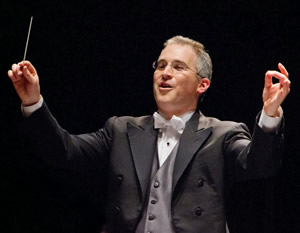Two mighty masterpieces crowned the concluding program of the Masterworks series of the Greensboro Symphony Orchestra: Beethoven’s “Emperor” Piano Concerto and Shostakovich’s multifaceted Symphony No. 5. At the podium was GSO Artistic Director Dmitry Sitkovetsky, leading the musicians in a somewhat bittersweet last performance in War Memorial Auditorium, which has a date with the wrecking ball later this year. The consolation is the slated construction of the new Steven Tanger Center for the Performing Arts in downtown Greensboro.
Beethoven was too deaf to be the soloist for his fifth and final piano concerto in E-flat Major, Op. 73 (“Emperor”). Apparently, the English publisher of the concerto, Johann Baptist Cramer, gave the work the nickname. Be that as it may, one senses Beethoven would have been wowed by Thursday night’s performer, the 30-something Alexander Schimpf. From opening forte chords and ensuing piano cadenza, it was clear that Schimpf is a powerful player who brought the virtuosity of the score to the fore. Indeed, one sometimes forgets what a showpiece the opening measures are: cascade upon cascade of arpeggios, trills and scales, all played by Schimpf with bravura and clarity.
Of course, after the opening piano proclamation, the pianist must remain mute for three and a half minutes of orchestral exploration of the main themes of the first movement. But when the soloist returned to his music making, he not only continued to display the brilliant playing of the outset, but also revealed a musical soul searching for the beautiful, lyric melodies that are also part of this magnificent work.
Nowhere is lyricism more evident than in the hushed second movement. Here one hears the inner Beethoven, the composer who struggled his entire life to overcome not only his deafness but also his inability to successfully function in a society that was at odds with his personality. Pure romanticism, exquisitely explored by Schimpf’s subtly nuanced music making.
The final movement is a curious romp with a limp, an assertive theme with a rhythmic twist. It was no-holds-barred playing by both soloist and orchestra. Sitkovetsky and Schimpf kept in close contact with each other, and the result was good ensemble from beginning to end, with only a couple of passages that did not end together.
The good-sized crowd leapt to its feet, and the pianist mesmerized listeners with a gently beautiful performance of Bach’s “Sheep May Safely Graze,” arranged by Egon Petri (whose own performance of the work may be heard here).
Shostakovich’s Symphony No. 5 (1937) is legendary in the composer’s dealings with the Soviet authorities, which had lambasted his opera Lady Macbeth of Mtsensk District for being too complex. Urban legend has it that he subsequently wrote the Fifth Symphony as “a Soviet artist’s creative response to justified criticism.” Whatever truth there is to this statement, it successfully put the composer back in the good graces of the arbiters of art; it has become one of his most frequently performed works.
The four-movement work opens with a daunting, jerky tune, in canon between the high and low strings; the stern message pervades the movement. Breath-taking melodic tunes that soar in the stratosphere are also very much in evidence. But wait there’s more: stirring string unison, giant climaxes, and a gentle conclusion featuring an ethereal celesta ascending line.
The second movement, Allegretto, sardonically dances along, with perky solos for the winds section, providing a showpiece for great playing. The Largo is as intense as it gets – poignant independent string lines collide, creating incredible dissonances. Extremely hushed passages allowed the ensemble to play as soft as I’ve heard them.
The bustling finale brings the works to a mighty and climactic conclusion (although the full minute of D Major coda seems a bit much for the heroic outcome). Maestro Sitkovetsky was clearly in his element in this Soviet symphony, and his conducting seemed especially inspired. Indeed, in the final movement he conducted like a man possessed, conjuring up powerful brass choruses, demanding impassioned string playing, and delighting in the large percussion section that aided and abetted the over-the-top finish.
The concert was a fitting closing to both the GSO season and the 55-year run of music-making in the War Memorial Auditorium.
The program will however be repeated on May 10, but in Dana Auditorium, on the Guilford College campus. For details, see the sidebar.












